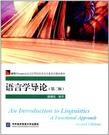语言学导论
出版时间:2012-9 出版社:对外经济贸易大学出版社 作者:杨潮光 页数:377
Tag标签:无
内容概要
《展望(Prospect)全国高等院校英语专业系列精品教材:语言学导论(第2版)》采用功能派语言学的观点编写,与迄今为止国内已出版的各类语言学导论教材相比,具有如下鲜明特点: 一、本书着重从语言的社会功能出发,书中的第一部分在揭示了语言性质和功能之后,首先讨论语义学的基本内容,即人们是如何通过语言来交流信息,表达思想的;然后讨论词法学、词汇学及句法学,即如何用词汇和句子来表达不同的语义;最后讨论语音学和音位学,即如何利用言语的语音和音位系统来传递语义。 二、本书的第二部分揭示了语言与思维、现实,语言与文化、社会、个人的密切关系,意在引导学员宏观地认识语言,深入地理解语言学的理论价值和实用价值。 三、本书的最后几章探讨语言与商业、语言与政治的密切关系,并讨论语言学对外语“教”与“学”的启迪,重点介绍功派语言教学的一些观点。 四、本书力求深入浅出,在介绍相关理论的同时,使用大量生动典型的语言实例,以期达到学术性和实用性的完美结合。本书还为各章节配有复习题和笔头作业题,并列出所推荐的参考书目。
书籍目录
Part OneChapter l Language and Linguistics1.1.Nature and Properties of Human Language1.1.1.The nature of human language1.1.2.The comparison between human language and animal communication systems 1.1.3.The definitions of language1.2.Functions of Human Language1.2.1.From a learner's individual, pragmatic point of view1.2.2.From an interactive point of view1.2.3.From a social point of view1.3.Linguistics1.3.1 The definition of linguistics1.3.2.The major branches of general linguistics1.3.3.The basic concepts in linguistics1.3.4.The major modern linguistic schools and theories1.3.5.Representative figures of schools of linguistics1.4.The Study of Language in Functional ApproachTooics for DiscussionBooks for ReferenceExercises for the ChapterPart TwoChaDter 2 Language, Thought and Reality2.1.Early Theories Concerning the Relationship Between Language, Thought and Reality2.1.1.Monism2.1.2.Dualism2.1.3.Saussure's Sign Theory, Richard and Ogden's Semantic Triangle2.2.Sapir-Whorf Hypotheses2.2.1.Introduction to Sapir and Whorf2.2.2.Sapir's Linguistic Relativity2.2.3.Whorf's Linguistic Determinism2.3.Argument Concerning the Issue2.3.1.Supporting views2.3.2.Criticism on Sapir-Whorf Hypothesis2.4.Other Views Concerning the Relationship Between Language, Thought and Reality2.5.The Insight the Debate Has Brought to Us2.6.Comparison of the Thinking Patterns of Chinese and English- Speaking PeopteTopics for DiscussionBooks for referenceExercises for the ChapterChapter 3 Language, Culture, Society and Individuals3.1.The Relationship Between Language and Culture3.1.1.Definitions of culture3.1.2.The nature of culture3.1.3.The universality in biology, culture and language3.1.4.The peculiarity in biology, culture and language3.1.5.The dialectal relation between lantzuage and culture3.1.6.Problems concerning language and culture3.2.The Relationship Between Language and Society3.2.1.Language is first of all a social phenomenon.3.2.2.Human societies are varied, soj are their languages.3.3.The Relationship Between Language and Individuals3.3.1.Language is an important means of survival for every individual.3.3.2.Language is a tool of learning for everybody.3.3.3.Every speaker has his own style.3.3.4.Every speaker is a member of the soeech communitv.3.4.Comparison Between the Two Major Culture Models3.4.1.High-Context Cultures and Low-Context Cultures3.4.2.P-Time Culture and M-Time Culture3.5.Cross-Cultural Communication3.5.1.Problems in cross-cultural communication3.5.2.The importance of non-verbal communication3.5.3.The ability to communicate effectively in cross-cultural settingsTopics for DiscussionBooks for ReferenceExercises for the ChapterChapter 4 Language in Business and Language in Politics4.1.Language in Business4.1.1.Language and business4.1.2.English in business in a broader sense4.1.3.English in business in a narrower sense4.1.4.Culture and its implication in business4.1.5.How to improve competence in business English?……Part threeAppendix 1 Introduction to the CourseAppendix 2 Syllabus for the CourseAppendix 3 The Constituent Structure of English SemologyAppendix 4 The Constituent Structure of English GrammarAppendix 5 The Constituent Structure of English PhonologyModel Key to ExercisesGeneral Bibliography
图书封面
图书标签Tags
无
评论、评分、阅读与下载
用户评论 (总计0条)
推荐图书
- 三个吃冰淇淋的大王
- 小贝流浪记
- 小猫做饭
- 金眼圈
- 日本战后小说选
- 小雪人的信
- 小狼请客
- 操心的猴子画家
- 横尾忠則コラ-ジュ ― 1972-2012
- トレヴァ-・ブラウンのアリス ― トレヴァ-・ブラウン画集 (新装版)
- 最新日米電脳好色絵巻円盤
- 江戸艶本ベストセラー
- 爆笑动物剧场(3-5册)
- 爆笑动物剧场(1-2册)
- 海邊的假情人
- 変態好辞苑
- ロマンポルノ・ロマン
- 香港版 裸のアイドル女優たち&エロチック・ムービーズ
- 戦後まんがの表現空間
- 中国盗墓传奇
- 燎原教育·高中全易通
- 新世纪英才教程·英才小灵通·同步培优作业本(4年级下册)
- 经典临本 素描静物
- 党纪政纪典型案例解析
- 春秋:云南省博物馆60年
